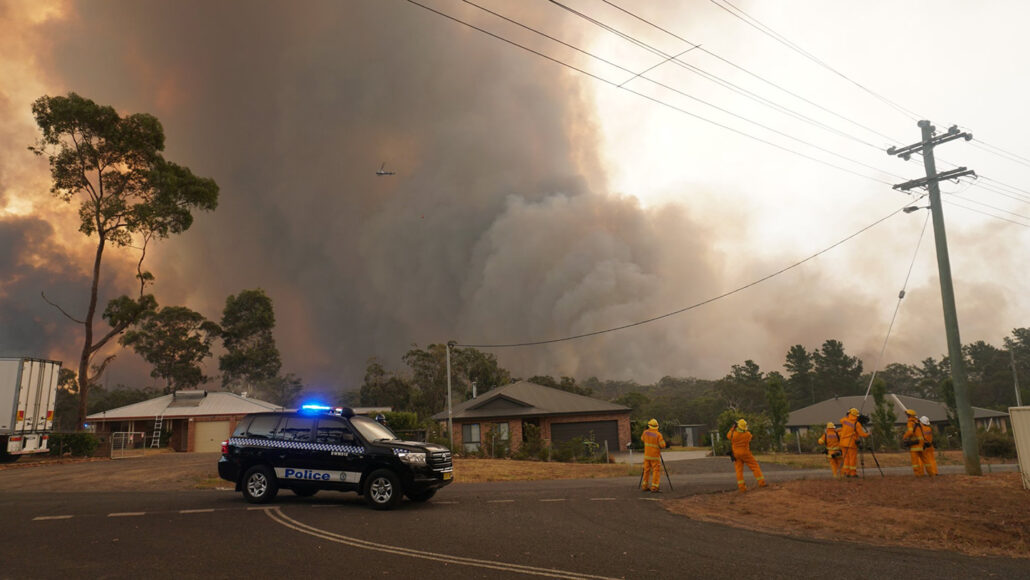Increasingly large blazes threaten to undo decades of work to help Earth’s protective layer

A towering cloud of smoke rises over the Green Wattle Creek bushfire
on December 21, 2019, near the township of Yanderra in New South Wales, Australia.
By Carolyn Gramling
MARCH 17, 2022
Towers of smoke that rose high into the stratosphere during Australia’s “black summer” fires in 2019 and 2020 destroyed some of Earth’s protective ozone layer, researchers report in the March 18 Science.
Chemist Peter Bernath of Old Dominion University in Norfolk, Va., and his colleagues analyzed data collected in the lower stratosphere during 2020 by a satellite instrument called the Atmospheric Chemistry Experiment. It measures how different particles in the atmosphere absorb light at different wavelengths. Such absorption patterns are like fingerprints, identifying what molecules are present in the particles.
The team’s analyses revealed that the particles of smoke, shot into the stratosphere by fire-fueled thunderstorms called pyrocumulonimbus clouds, contained a variety of mischief-making organic molecules (SN: 12/15/20). The molecules, the team reports, kicked off a series of chemical reactions that altered the balances of gases in Earth’s stratosphere to a degree never before observed in 15 years of satellite measurements. That shuffle included boosting levels of chlorine-containing molecules that ultimately ate away at the ozone.
Ozone concentrations in the stratosphere initially increased from January to March 2020, due to similar chemical reactions — sometimes with the contribution of wildfire smoke — that produce ozone pollution at ground level (SN: 12/8/21). But from April to December 2020, the ozone levels not only fell, but sank below the average ozone concentration from 2005 to 2019.
Earth’s ozone layer shields the planet from much of the sun’s ultraviolet radiation. Once depleted by human emissions of chlorofluorocarbons and other ozone-damaging substances, the layer has been showing signs of recovery thanks to the Montreal Protocol, an international agreement to reduce the atmospheric concentrations of those substances (SN: 2/10/21).
But the increasing frequency of large wildfires due to climate change — and their ozone-destroying potential — could become a setback for that rare climate success story, the researchers say (SN: 3/4/20).
Questions or comments on this article? E-mail us at feedback@sciencenews.org
CITATIONS
P. Bernath, C. Boone and J. Crouse. Wildfire smoke destroys stratospheric ozone. Science. Vol. 375, March 18, 2022, p. 1,292. doi: 10.1126/science.abm5611.
By Carolyn Gramling
MARCH 17, 2022
Towers of smoke that rose high into the stratosphere during Australia’s “black summer” fires in 2019 and 2020 destroyed some of Earth’s protective ozone layer, researchers report in the March 18 Science.
Chemist Peter Bernath of Old Dominion University in Norfolk, Va., and his colleagues analyzed data collected in the lower stratosphere during 2020 by a satellite instrument called the Atmospheric Chemistry Experiment. It measures how different particles in the atmosphere absorb light at different wavelengths. Such absorption patterns are like fingerprints, identifying what molecules are present in the particles.
The team’s analyses revealed that the particles of smoke, shot into the stratosphere by fire-fueled thunderstorms called pyrocumulonimbus clouds, contained a variety of mischief-making organic molecules (SN: 12/15/20). The molecules, the team reports, kicked off a series of chemical reactions that altered the balances of gases in Earth’s stratosphere to a degree never before observed in 15 years of satellite measurements. That shuffle included boosting levels of chlorine-containing molecules that ultimately ate away at the ozone.
Ozone concentrations in the stratosphere initially increased from January to March 2020, due to similar chemical reactions — sometimes with the contribution of wildfire smoke — that produce ozone pollution at ground level (SN: 12/8/21). But from April to December 2020, the ozone levels not only fell, but sank below the average ozone concentration from 2005 to 2019.
Earth’s ozone layer shields the planet from much of the sun’s ultraviolet radiation. Once depleted by human emissions of chlorofluorocarbons and other ozone-damaging substances, the layer has been showing signs of recovery thanks to the Montreal Protocol, an international agreement to reduce the atmospheric concentrations of those substances (SN: 2/10/21).
But the increasing frequency of large wildfires due to climate change — and their ozone-destroying potential — could become a setback for that rare climate success story, the researchers say (SN: 3/4/20).
Questions or comments on this article? E-mail us at feedback@sciencenews.org
CITATIONS
P. Bernath, C. Boone and J. Crouse. Wildfire smoke destroys stratospheric ozone. Science. Vol. 375, March 18, 2022, p. 1,292. doi: 10.1126/science.abm5611.

About Carolyn Gramling
Carolyn Gramling is the earth & climate writer. She has bachelor’s degrees in geology and European history and a Ph.D. in marine geochemistry from MIT and the Woods Hole Oceanographic Institution.
No comments:
Post a Comment